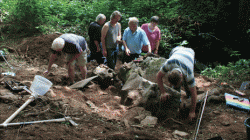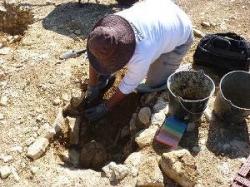- 01 JUILLET
- INDI-UNI : 
PRE-INSCRIPTION : 15 Juin – 15 Août
PRE-REGISTRATION: June 15th - August 15th
- ROYAUME UNI –  Cwmbran - Amateur archaeologists have uncovered what they say may be a holy well in woodland in Cwmbran, Torfaen.They were working on a dig to discover more about a settlement that dates back to the 16th Century that they already knew about. But they came across the well at Green Meadow Woods and believe it is much older. Richard Davies from the Ancient Cwmbran Society said it may shed light on the area's religious history. Holy wells can date back to the second and third centuries. The water in holy wells was said to have healing qualities. Field archaeologists Roger Burchill said: "It is comprised of packed stones that are all placed with the front forming a face to the well itself. All we can say about it at the moment is the structure is totally different to what we have on the bank."We have a wall, we have some paths, we have a possible building up on the bank and we have this well. Connecting them together is the trick." One of the best known holy wells in Wales is St Winefride's Well in Holywell which gives the town its name. Legend has it a well sprung from the ground at the place where St Winefride, a noblewoman who lived during the 7th Century, was murdered by a local chieftain after she spurned his advances. Her suitor, Caradog, is said to have cut off her head with a sword but she was restored to life by her uncle, St Beuno, and dedicated herself to holy works, becoming a nun and abbess.
Cwmbran - Amateur archaeologists have uncovered what they say may be a holy well in woodland in Cwmbran, Torfaen.They were working on a dig to discover more about a settlement that dates back to the 16th Century that they already knew about. But they came across the well at Green Meadow Woods and believe it is much older. Richard Davies from the Ancient Cwmbran Society said it may shed light on the area's religious history. Holy wells can date back to the second and third centuries. The water in holy wells was said to have healing qualities. Field archaeologists Roger Burchill said: "It is comprised of packed stones that are all placed with the front forming a face to the well itself. All we can say about it at the moment is the structure is totally different to what we have on the bank."We have a wall, we have some paths, we have a possible building up on the bank and we have this well. Connecting them together is the trick." One of the best known holy wells in Wales is St Winefride's Well in Holywell which gives the town its name. Legend has it a well sprung from the ground at the place where St Winefride, a noblewoman who lived during the 7th Century, was murdered by a local chieftain after she spurned his advances. Her suitor, Caradog, is said to have cut off her head with a sword but she was restored to life by her uncle, St Beuno, and dedicated herself to holy works, becoming a nun and abbess.
http://www.bbc.co.uk/news/uk-wales-south-east-wales-13954829
- CANADA – Nunavut - Les recherches reprendront cet été pour retrouver les épaves des navires de l'explorateur britannique Sir John Franklin, disparus il y a un siècle et demi dans les glaces de l'archipel arctique canadien. À la mi-août, des archéologues parcourront la région située à l'ouest de l'île King William, au Nunavut, pour tenter de localiser les deux navires perdus, l'Erebus et le Terror, lors d'une expédition en 1845. Cette disparition reste l'un des plus grands mystères maritimes jamais résolus. Certains restes humains de l'équipage ont été retrouvés, ainsi que des preuves troublantes de cannibalisme parmi les matelots affamés. Les archéologues prévoient également une plongée pour explorer l'épave de l'Investigator, retrouvée l'été dernier au large de l'île de Banks. L'Investigator avait découvert au début des années 1850 le dernier tronçon du Passage du Nord-Ouest, mais a aussi été perdu lors de la recherche pour retrouver l'expédition Franklin. Le navire avait été abandonné dans les glaces en 1853. En 2010, les archéologues de Parcs Canada ont localisé les restes de l'Investigator dans la baie Mercy. Ils ont aussi trouvé les sépultures de trois membres d'équipage et une cache d'équipements laissée par le capitaine du navire, Robert McClure. En mai 1845, Franklin et 134 hommes quittent l'Angleterre à bord de deux navires robustes, les HMS Erebus et HMS Terror, pour trouver le Passage du Nord-Ouest. Les équipages disposent du matériel dernier cri, comme un moteur à vapeur, du chauffage, et de la nourriture pour trois ans. Des conserves contaminées par le plomb et une erreur de navigation mèneront la mission à sa perte. Malgré d'intenses recherches, les bateaux n'ont jamais été retrouvés.
http://fr-ca.actualites.yahoo.com/arch%C3%A9ologie-les-recherches-reprennent-pour-trouver-les-navires-200807097.html
- FRANCE –  St Germain du Puy / Boubards - Sur le tracé de la future rocade nord-est de Bourges, les archéologues s'activent depuis 2009. Des fouilles qui ont mis au jour une nécropole mérovingienne, une ferme gauloise et une villa romaine. Une opération de fouilles préventives est en cours sur la commune de Saint-Germain. Ces fouilles ont révélé une nécropole mérovingienne et de galeries d'extractions du calcaire, d'époque romaine. Le chantier de fouille, qui a commencé à la mi-juin, doit se poursuivre jusqu'à la fin du mois d'août. Quelques mètres plus loin, aux Boubards, s'est déroulé un autre chantier. Une entreprise d'archéologie préventive, Archeodunum, s'est chargée des travaux, de mars à juin 2011. Sur deux hectares a été repérée une ferme gauloise du Ier siècle avant J.-C. Et à côté, un domaine agricole romain, occupé du Ier au IVe siècle après J.-C.
St Germain du Puy / Boubards - Sur le tracé de la future rocade nord-est de Bourges, les archéologues s'activent depuis 2009. Des fouilles qui ont mis au jour une nécropole mérovingienne, une ferme gauloise et une villa romaine. Une opération de fouilles préventives est en cours sur la commune de Saint-Germain. Ces fouilles ont révélé une nécropole mérovingienne et de galeries d'extractions du calcaire, d'époque romaine. Le chantier de fouille, qui a commencé à la mi-juin, doit se poursuivre jusqu'à la fin du mois d'août. Quelques mètres plus loin, aux Boubards, s'est déroulé un autre chantier. Une entreprise d'archéologie préventive, Archeodunum, s'est chargée des travaux, de mars à juin 2011. Sur deux hectares a été repérée une ferme gauloise du Ier siècle avant J.-C. Et à côté, un domaine agricole romain, occupé du Ier au IVe siècle après J.-C.
http://www.leberry.fr/editions_locales/bourges/une_necropole_merovingienne_decouverte_sur_la_future_rocade_nord_est_de_bourges_video_@CARGNjFdJSsBHh8ABRs-.html
- CAMBODGE –  Angkor - It has taken half a century, but archaeologists in Cambodia have finally completed the renovation of an ancient Angkor temple described as the world's largest three dimensional puzzle. The restoration of the 11th-century Baphuon ruin is the result of decades of painstaking work, hampered by tropical rains and civil war, to take apart hundreds of thousands of sandstone blocks and piece them back together again. Built around 1060 by King Udayadityavarman II in honour of the Hindu god Shiva, Baphuon was the country's largest religious building at the time, 35 metres high (114 feet) and measuring 130 by 104 metres (426 x 340 feet). In the 16th century, a 70-metre long reclining Buddha statue was built into a wall on the second level using stones from the top of the temple. These two phases of construction, hundreds of years apart, further complicated the restoration.
Angkor - It has taken half a century, but archaeologists in Cambodia have finally completed the renovation of an ancient Angkor temple described as the world's largest three dimensional puzzle. The restoration of the 11th-century Baphuon ruin is the result of decades of painstaking work, hampered by tropical rains and civil war, to take apart hundreds of thousands of sandstone blocks and piece them back together again. Built around 1060 by King Udayadityavarman II in honour of the Hindu god Shiva, Baphuon was the country's largest religious building at the time, 35 metres high (114 feet) and measuring 130 by 104 metres (426 x 340 feet). In the 16th century, a 70-metre long reclining Buddha statue was built into a wall on the second level using stones from the top of the temple. These two phases of construction, hundreds of years apart, further complicated the restoration.
http://www.google.com/hostednews/afp/article/ALeqM5jrbPvOVvNyeV0xjohqzBmQhNSYrA?docId=CNG.4c50d4e5f6d29eb93f5d23744d330c7f.3c1
- PAKISTAN – Galla - The land mafia in Khyber Pakhtunkhwa province has grabbed a 2,000-year old archaeological site in Swabi and the old owner, who lives in Sweden, is desperately trying to stop them from destroying the site. A known Pakistani educationist has sent an urgent message from Sweden regarding the threat by the land mafia to the important Hindu Shahi-era archaeological site on his property in Galla village in Swabi district. Dr Shah Nazar Khan, an associate professor at the Department of Archaeology, University of Peshawar, confirmed that the archaeological site at Galla village was rare and important as it belonged to the Hindu Shahi period. “We have only one other Hindu Shahi period archaeological site and that is also in Swabi district at Hund village located on the banks of river Indus,” he pointed out. Dr Shah Nazar told The News that he surveyed the archaeological site at Galla in 2003. “It is a fort-like structure and at one point the wall was fourteen and a half feet tall ”.
http://www.thenews.com.pk/TodaysPrintDetail.aspx?ID=55435&Cat=2&dt=7/1/2011
- CANADA – Metlakatla - A human skeleton was unearthed in Metlakatla a few weeks ago. According to the Prince Rupert RCMP, the remains were discovered when someone dug through a basement wall to repair a sewer line. When the skeletal remains were found, the band called the RCMP and gave forensic investigators photographs of the skeleton for them to analyze. Investigators determined that the bones are very old . David Archer is a local archeologist who has worked in the Prince Rupert area for several years, and teaches and Northwest Community College. While he wasn’t been told about the find, he says that he’s not surprised that human remains would be found underneath the modern-day Metlakatla Village. “There are two archeological sites in the current area of Metlakatla Village, so it’s not at all unusual if there’s any kind of construction work or disturbance of the ground in that area that human remains might turn up,” says Archer. Archer says that deposits in the Metlakatla area can be up to 5,000 years old and that most of the human remains found around Prince Rupert are typically 1,500 to 3,000 years old. “Its definitely a problem when you have an active community on top of an archeological site, people can’t do very much without disturbing the ground in one way or another,” says Archer.
http://www.bclocalnews.com/news/124672909.html
- ROYAUME UNI – Musselburgh - They may not look like much today, but they are a precious remnant of a spectacular garden walk, once one of the finest in Britain, and now all but forgotten. More than 250 years ago, the decorated planks covered the "shell grotto" at Newhailes House in Musselburgh. The planks, decorated with shells and sparkling pieces of industrial waste, were found by archeologists in a burn close to the grotto in 2001. They had originally been mounted on the walls of the grotto some time between 1721 and 1751. After a decade of being kept at the NTS conservation studio at Hopetoun House, they have now been returned to Newhailes, thanks to the creation of a special archeological finds store in the house's stables.
http://news.scotsman.com/scotland/Historic-planks-returned-to-39shell.6793022.jp